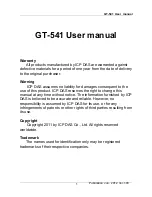
RIVERBED WHITEWATER QUICK START GUIDE
© 2012 Riverbed Technology. All rights reserved.
35
2. Recover the original configuration of Whitewater to the new Whitewater at the DR site.
Browse to the menu
Configure
->
Setup Wizard
(Figure 41) and import the previously saved configuration file. Make
sure you leave the default “Import Shared Data Only” checkbox selected.
Figure 41 Setup Wizard to Import Configuration
3. Configure Whitewater Data Interfaces to the new network environment at the DR site.
Browse to the menu
Configure
->
Networking -> Data Interfaces
(Figure 42) and configure Data Interfaces network
information.
Figure 42 Data Interfaces Configuration Menu
4. Once the configuration is complete, connect to the Whitewater CLI using SSH and initiate the Replication Recovery procedure.
For details, see the
Riverbed Command-Line Interface Reference Manual
. Issue the following commands:
whitewater > enable
whitewater # configure terminal
whitewater (config) # no service enable
whitewater (config) # replication recovery enable
whitewater (config) # service restart
Note that the replication recovery enable command will fail to execute if the optimization service is enabled, or if Whitewater
detects existing data in the new Whitewater cache. Assuming this is a new, empty Whitewater gateway, you will not receive any
failures and the commands will all be executed without error. This process can take a few seconds to a few hours depending on
the backup(s) being restored. During the recovery process, the system communicates with the cloud provider and recovers all the
namespace files that existed before the failure.
5. (Optional) Because the recovery process downloads only the namespace and metadata, initial file access might be slow,
because Whitewater downloads all of the data from the cloud. Therefore, it is recommended that you also populate the actual data
from the cloud back onto the new Whitewater in order to accelerate the recovery of your production systems. To do so, enter the
following:
whitewater (config) # datastore prepop {[num-days <number of days>] | [pattern <pattern>] |
[recursive]}





































